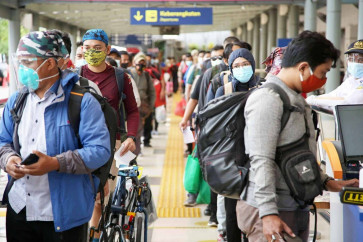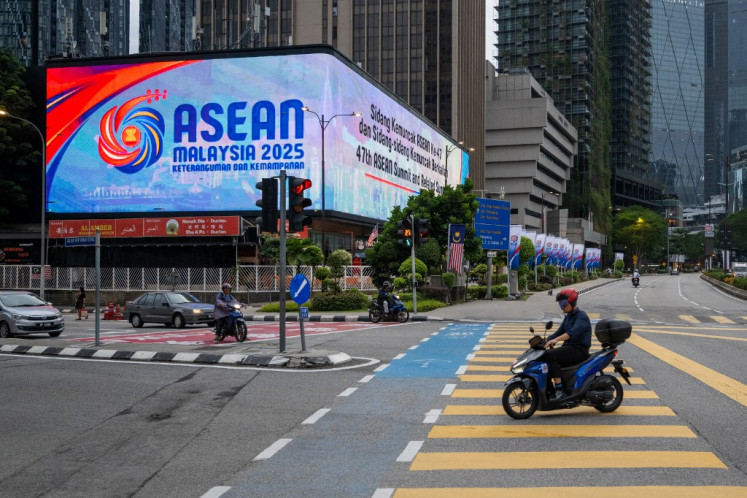Popular Reads
Top Results
Can't find what you're looking for?
View all search resultsPopular Reads
Top Results
Can't find what you're looking for?
View all search resultsSlow, easy & happy
Boys have fun near Dili seaport
Change text size
Gift Premium Articles
to Anyone
B
span class="caption" style="width: 398px;">Boys have fun near Dili seaport.When I told friends that I would come to Dili, Timor Leste, some of them wondered and asked since when had the city become a hot holiday destination?
Even a friend who has lived there for three years said it was a boring city due to its lack of entertainment. Surely, that would not be a problem as I would only stay there for a couple of weeks and modern entertainment is the last thing I think about on holiday.
Also, I would stay in Dili for free as my travel partner, who has a job there, offered free accommodation.
The big day arrived. My first impression of Dili? The city is ‘easy’. That afternoon, the Nicolau Labato international airport was busy with arrivals from Bali. I joined the queue at immigration to get my visa on arrival, which surprisingly was easy and quick.
Knowing that I was from Indonesia, the officer at the counter began to speak Indonesian and asked how many days I would like to stay and made some small talk about Jakarta. After finishing immigration clearance, I was quick to conclude that the city is beautiful and laid back. It made me jealous of the fact that the capital city where I live (Jakarta) is too far removed from this simplicity in life.
Dili also is a place where McDonalds and KFC do not exist (yet), although there was Coca-Cola aplenty. Yet, the city offers so much good international food served in sprawling western style cafes catering to the many expatriates living there.
A variety of beers is also available, including Indonesian Bintang and Singaporean Tiger. But fresh coconut is the way to go while cherishing every second watching the sunset.
During my visit to Timor Leste (the official Portuguese name) or Timor Lorosa’e (as locals call it in Tetun, the local language) in August, I found that the country was heavy with anticipation as it was gearing up for Tour de Timor (due in the second week of September).
This cycling event has been held annually since 2009, trying to attract international professional cyclists and tourists alike who love mountain biking. Tour de Timor prides itself on its amiable progress and pins its hopes on becoming the most sought after mountain bike race in the southern hemisphere.
East Timor is really gearing up to welcome as many visitors as possible in the hope that tourism can drive the country’s economy. A little more than a decade after its secession from Indonesia in 1999, this youngest of Southeast Asian nations has shown tremendous progress in many aspects, including politics and the economy.
However, there is a worry that the apparently growing economy is artificial as it is just an economic bubble from the presence of thousands of foreigners as part of UN missions to assist the country’s progress toward a fully independent nation.
Aware of this situation, the government of Timor Leste looks to tourism in the hope that the country’s raw beauty and fascinating history will draw foreign visitors to come and spend their cash to boost Timor’s economy.
In Dili, I enjoyed my day strolling along the main waterfront that houses Dili’s seaport and is located across from the main government complex that houses the palacio de governo (parliamentary building) and other embassies as well as international NGO offices.
On a typical weekend, I would join some friends heading to Pasir Putih (Areia Branca) beach down toward the giant Jesus statue which stands in the eastern part of the city. This beach is the most popular destination for both locals and foreigners who love to play in the water—swimming or kayaking.
Some lazy bums like me would just sit or lie down on the sand reading books, or just staring out at the clear turquoise water in front of us. Occasionally there was a group of well built Portuguese policemen sunbathing in their swimming trunks. Herds of goats and pigs often walked freely on the beach, sharing this paradise with the people.
I learned before my arrival that Timor offers a fantastic underwater experience for scuba divers and snorkeling enthusiasts. In Timor, certified scuba divers usually join either DIVE Timor Lorosa’e, Explore Timor or Freeflow Diving to explore the island’s rich undersea environment.
Most of the famous diving destinations are around Dili, Atauro and Jaco Island. The diving operators also offer a diving course and snorkeling sessions. However, due to my (lack of) swimming abilities, watching the calm blue water while sipping every drop of my coconut water was a wiser option for enjoying the day.
Sipping a cup of coffee was something that I also liked doing, usually in one of the bars or restaurants sprawling along the embassy roads.
Yes, coffee is big in Timor and part of the country’s history. Coffee plantation was first introduced to Timor in 1815 by Portuguese colonizers, following the decline in sandalwood that had been the island’s main natural product. Today, coffee is the main export of Timor apart from sandalwood and marble and among the biggest suppliers to fair trade coffee in the world.
With the arrival of foreign visitors and the sprawling western eateries catering for international tastes, the local coffee is also served in western styles such as cappuccino or latte, just as you fancy it.
As a first timer to Timor, I would not miss any of the touristy things recommended by Lonely Planet. Climbing the hill to reach the Jesus Statue (Cristo Rei) at the top of Cape Fatucama in the eastern part of Dili was one mission I was determined to accomplish.
The massive 27-meter high statue of Cristo Rei was built by the Indonesian army in 1996 to mark the ‘integration’ of Timor as Indonesia’s 27th province. The statue is the second highest after the statue of Christ Redemeer in Rio de Janeiro in Brazil, which reaches 38 meters in height.
Despite struggling, I made it to the top to get a breathtaking view of the white and quiet bay. A beautiful sea breeze washed away all the tiredness from my muscles and my shortness of breath.
I also managed to climb another hill and greeted the Pope John Paul II statue, erected in 2007 in the western end of Dili to commemorate the visit of the leader of the world’s Catholics in 1989. As the visit was followed by riots involving many students who called for freedom and independence, the statue is also seen as a symbol of freedom for the Timorese.
TO DO IN DILI:
You may follow Lonely Planet’s recommendations to enjoy the city, but here are some other options for your short visit to Dili:
Climb Ramos Horta Hill (go to the street where Horta’s palace is located) for something that is less touristy but also good for exercise. Start early at about 5 a.m. to enjoy the magnificent sunrise from atop the hill.
Enjoy a breakfast ON the beach under a tree. Beachside cafés do a beautiful western style breakfast and a nice coffee and fresh juice. Lunch is also an option and sipping a cold coconut juice can be just as satisfying as a bottle of beer.
Visit the Alola Foundation shop to find some gifts made of tais (traditional woven cloth) and some little souvenirs for loved ones at home. Alola Foundation, founded by first lady Kirsty Gusmao, works to improve the life of women and children in Timor. The foundation’s works are divided into five main categories of maternal and child health, education, economic development, advocacy and management.
Visit Arte Moris art center, a non-profit art center that teaches art to children for free. The artists will happily provide guided tours of their humble ‘home’ that is full of vibrant art works.
Sip a cup of Timor coffee accompanied by a mouthwatering Portuguese tart in Hotel Timor. Have your coffee black to neutralize the extra sweet tart.
Gobble in the Dark in Pantai Kelapa: eating out local style for a delicious dinner of grilled chicken, fish or seafood with katupa (yellowed rice cooked in coconut leaves).
Sunrise in Dili.FAST FACTS
How to get there: Fly from Darwin, Australia with Timor Air North or from Bali with Merpati or Batavia Airlines.
Accommodation: Hotels in Dili can be a headache as they are not cheap and there are not many options. Hotel Timor, Esplanada and Hotel Dili are options for those on a generous budget. As for budget travelers, check in at Dili Backpackers or stay with locals if you are a feeling a bit adventurous.
Beyond Dili: If you have time, check out of the capital Dili and hop on a ferry to Atauro island for a day trip. If you want to see what the mainland is like, drive down to Maubesse for the cooler air and aroma of coffee plantations. Jaco Island is said to be breathtakingly beautiful and can be reached with a six-hour drive plus 10-minute ferry ride.
Volunteering in Timor: Volunteerism has plenty of outlets in Timor. Many organizations can channel your altruistic passion for Timor as the country is still wide open to helping hands, especially in the health and education fields. Australian Volunteer International as well as some universities in Brazil and Portugal have sent their students to work there. You can also find local organizations to arrange for your own volunteer work.











